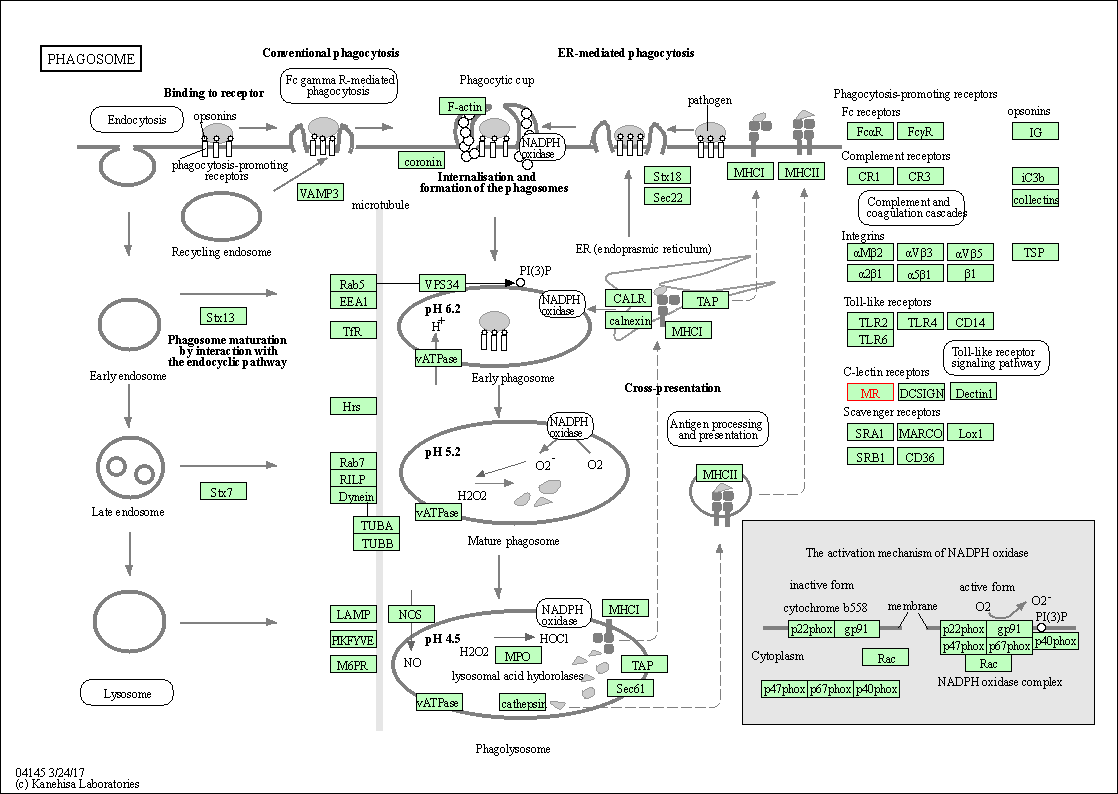Target Information
| Target General Information | Top | |||||
|---|---|---|---|---|---|---|
| Target ID |
T46702
|
|||||
| Target Name |
Secretory phospholipase A2 receptor (PLA2R)
|
|||||
| Synonyms |
Soluble secretory phospholipase A2 receptor; Soluble PLA2R; Soluble PLA2-R; PLA2-R; M-type receptor; CLEC13C; C-type lectin domain family 13 member C; 180 kDa secretory phospholipase A2 receptor
Click to Show/Hide
|
|||||
| Gene Name |
PLA2R1
|
|||||
| Target Type |
Patented-recorded target
|
[1] | ||||
| Function |
Acts as a receptor for phosholipase sPLA2-IB/PLA2G1B but not sPLA2-IIA/PLA2G2A. Also able to bind to snake PA2-like toxins. Although its precise function remains unclear, binding of sPLA2 to its receptor participates in both positive and negative regulation of sPLA2 functions as well as clearance of sPLA2. Binding of sPLA2-IB/PLA2G1B induces various effects depending on the cell type, such as activation of the mitogen-activated protein kinase (MAPK) cascade to induce cell proliferation, the production of lipid mediators, selective release of arachidonic acid in bone marrow-derived mast cells. In neutrophils, binding of sPLA2-IB/PLA2G1B can activate p38 MAPK to stimulate elastase release and cell adhesion. May be involved in responses in proinflammatory cytokine productions during endotoxic shock. Also has endocytic properties and rapidly internalizes sPLA2 ligands, which is particularly important for the clearance of extracellular sPLA2s to protect their potent enzymatic activities. The soluble secretory phospholipase A2 receptor form is circulating and acts as a negative regulator of sPLA2 functions by blocking the biological functions of sPLA2-IB/PLA2G1B. Receptor for secretory phospholipase A2 (sPLA2).
Click to Show/Hide
|
|||||
| UniProt ID | ||||||
| Sequence |
MLLSPSLLLLLLLGAPRGCAEGVAAALTPERLLEWQDKGIFVIQSESLKKCIQAGKSVLT
LENCKQANKHMLWKWVSNHGLFNIGGSGCLGLNFSAPEQPLSLYECDSTLVSLRWRCNRK MITGPLQYSVQVAHDNTVVASRKYIHKWISYGSGGGDICEYLHKDLHTIKGNTHGMPCMF PFQYNHQWHHECTREGREDDLLWCATTSRYERDEKWGFCPDPTSAEVGCDTIWEKDLNSH ICYQFNLLSSLSWSEAHSSCQMQGGTLLSITDETEENFIREHMSSKTVEVWMGLNQLDEH AGWQWSDGTPLNYLNWSPEVNFEPFVEDHCGTFSSFMPSAWRSRDCESTLPYICKKYLNH IDHEIVEKDAWKYYATHCEPGWNPYNRNCYKLQKEEKTWHEALRSCQADNSALIDITSLA EVEFLVTLLGDENASETWIGLSSNKIPVSFEWSNDSSVIFTNWHTLEPHIFPNRSQLCVS AEQSEGHWKVKNCEERLFYICKKAGHVLSDAESGCQEGWERHGGFCYKIDTVLRSFDQAS SGYYCPPALVTITNRFEQAFITSLISSVVKMKDSYFWIALQDQNDTGEYTWKPVGQKPEP VQYTHWNTHQPRYSGGCVAMRGRHPLGRWEVKHCRHFKAMSLCKQPVENQEKAEYEERWP FHPCYLDWESEPGLASCFKVFHSEKVLMKRTWREAEAFCEEFGAHLASFAHIEEENFVNE LLHSKFNWTEERQFWIGFNKRNPLNAGSWEWSDRTPVVSSFLDNTYFGEDARNCAVYKAN KTLLPLHCGSKREWICKIPRDVKPKIPFWYQYDVPWLFYQDAEYLFHTFASEWLNFEFVC SWLHSDLLTIHSAHEQEFIHSKIKALSKYGASWWIGLQEERANDEFRWRDGTPVIYQNWD TGRERTVNNQSQRCGFISSITGLWGSEECSVSMPSICKRKKVWLIEKKKDTPKQHGTCPK GWLYFNYKCLLLNIPKDPSSWKNWTHAQHFCAEEGGTLVAIESEVEQAFITMNLFGQTTS VWIGLQNDDYETWLNGKPVVYSNWSPFDIINIPSHNTTEVQKHIPLCALLSSNPNFHFTG KWYFEDCGKEGYGFVCEKMQDTSGHGVNTSDMYPMPNTLEYGNRTYKIINANMTWYAAIK TCLMHKAQLVSITDQYHQSFLTVVLNRLGYAHWIGLFTTDNGLNFDWSDGTKSSFTFWKD EESSLLGDCVFADSNGRWHSTACESFLQGAICHVPPETRQSEHPELCSETSIPWIKFKSN CYSFSTVLDSMSFEAAHEFCKKEGSNLLTIKDEAENAFLLEELFAFGSSVQMVWLNAQFD GNNETIKWFDGTPTDQSNWGIRKPDTDYFKPHHCVALRIPEGLWQLSPCQEKKGFICKME ADIHTAEALPEKGPSHSIIPLAVVLTLIVIVAICTLSFCIYKHNGGFFRRLAGFRNPYYP ATNFSTVYLEENILISDLEKSDQ Click to Show/Hide
|
|||||
| 3D Structure | Click to Show 3D Structure of This Target | AlphaFold | ||||
| Cell-based Target Expression Variations | Top | |||||
|---|---|---|---|---|---|---|
| Cell-based Target Expression Variations | ||||||
| Different Human System Profiles of Target | Top |
|---|---|
|
Human Similarity Proteins
of target is determined by comparing the sequence similarity of all human proteins with the target based on BLAST. The similarity proteins for a target are defined as the proteins with E-value < 0.005 and outside the protein families of the target.
A target that has fewer human similarity proteins outside its family is commonly regarded to possess a greater capacity to avoid undesired interactions and thus increase the possibility of finding successful drugs
(Brief Bioinform, 21: 649-662, 2020).
Human Tissue Distribution
of target is determined from a proteomics study that quantified more than 12,000 genes across 32 normal human tissues. Tissue Specificity (TS) score was used to define the enrichment of target across tissues.
The distribution of targets among different tissues or organs need to be taken into consideration when assessing the target druggability, as it is generally accepted that the wider the target distribution, the greater the concern over potential adverse effects
(Nat Rev Drug Discov, 20: 64-81, 2021).
Human Pathway Affiliation
of target is determined by the life-essential pathways provided on KEGG database. The target-affiliated pathways were defined based on the following two criteria (a) the pathways of the studied target should be life-essential for both healthy individuals and patients, and (b) the studied target should occupy an upstream position in the pathways and therefore had the ability to regulate biological function.
Targets involved in a fewer pathways have greater likelihood to be successfully developed, while those associated with more human pathways increase the chance of undesirable interferences with other human processes
(Pharmacol Rev, 58: 259-279, 2006).
Biological Network Descriptors
of target is determined based on a human protein-protein interactions (PPI) network consisting of 9,309 proteins and 52,713 PPIs, which were with a high confidence score of ≥ 0.95 collected from STRING database.
The network properties of targets based on protein-protein interactions (PPIs) have been widely adopted for the assessment of target’s druggability. Proteins with high node degree tend to have a high impact on network function through multiple interactions, while proteins with high betweenness centrality are regarded to be central for communication in interaction networks and regulate the flow of signaling information
(Front Pharmacol, 9, 1245, 2018;
Curr Opin Struct Biol. 44:134-142, 2017).
Human Similarity Proteins
Human Tissue Distribution
Human Pathway Affiliation
Biological Network Descriptors
|
|
|
There is no similarity protein (E value < 0.005) for this target
|
|
Note:
If a protein has TS (tissue specficity) scores at least in one tissue >= 2.5, this protein is called tissue-enriched (including tissue-enriched-but-not-specific and tissue-specific). In the plots, the vertical lines are at thresholds 2.5 and 4.
|
| KEGG Pathway | Pathway ID | Affiliated Target | Pathway Map |
|---|---|---|---|
| Phagosome | hsa04145 | Affiliated Target |

|
| Class: Cellular Processes => Transport and catabolism | Pathway Hierarchy | ||
| Degree | 3 | Degree centrality | 3.22E-04 | Betweenness centrality | 8.10E-04 |
|---|---|---|---|---|---|
| Closeness centrality | 1.52E-01 | Radiality | 1.20E+01 | Clustering coefficient | 0.00E+00 |
| Neighborhood connectivity | 2.00E+00 | Topological coefficient | 3.33E-01 | Eccentricity | 14 |
| Download | Click to Download the Full PPI Network of This Target | ||||
| Target Affiliated Biological Pathways | Top | |||||
|---|---|---|---|---|---|---|
| KEGG Pathway | [+] 2 KEGG Pathways | + | ||||
| 1 | Phagosome | |||||
| 2 | Tuberculosis | |||||
| References | Top | |||||
|---|---|---|---|---|---|---|
| REF 1 | Secretory phospholipase A2 enzymes as pharmacological targets for treatment of disease. Biochem Pharmacol. 2014 Aug 15;90(4):338-48. | |||||
If You Find Any Error in Data or Bug in Web Service, Please Kindly Report It to Dr. Zhou and Dr. Zhang.

